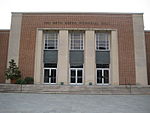Alan B. Miller Hall
2009 establishments in VirginiaCollege of William & Mary buildingsRobert A. M. Stern buildingsSchool buildings completed in 2009

The Alan B. Miller Hall became the home of the Mason School of Business at the College of William & Mary in Williamsburg, Virginia, United States in 2009. The building was designed by prominent firm Robert A.M. Stern Architects. The building has been awarded LEED Gold Certification after adhering to sustainability standards. It also houses the Mason School of Business Library. Constructed in a little over two years at a project cost of $75 million, Alan B. Miller Hall is named after alumnus Alan B. Miller '58, a healthcare management entrepreneur who founded Fortune 500 company Universal Health Services.
Excerpt from the Wikipedia article Alan B. Miller Hall (License: CC BY-SA 3.0, Authors, Images).Alan B. Miller Hall
Humelsine Parkway,
Geographical coordinates (GPS) Address Website Nearby Places Show on map
Geographical coordinates (GPS)
| Latitude | Longitude |
|---|---|
| N 37.26624 ° | E -76.71805 ° |
Address
College of William and Mary
Humelsine Parkway
23186
Virginia, United States
Open on Google Maps










